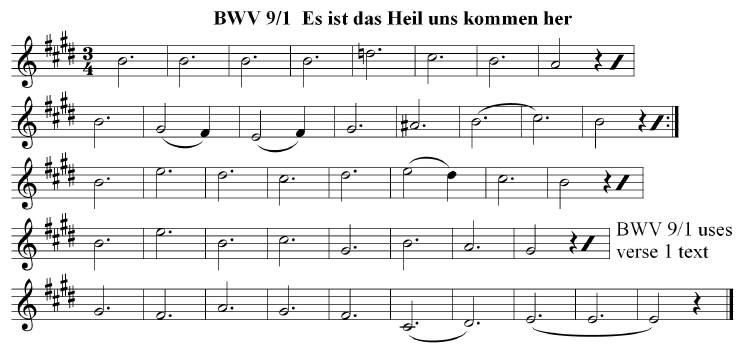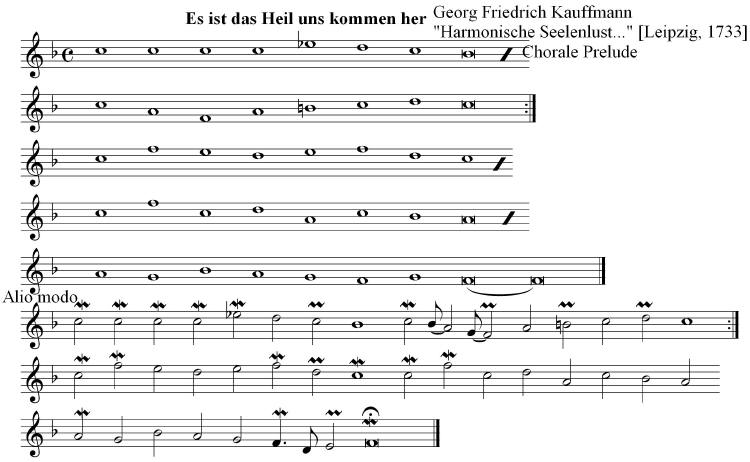|
Chorale Melodies used in Bach's Vocal Works
Es ist das Heil uns kommen her
|
|
Melody & Text | Use of the CM by Bach | Use of the CM by other composers |
| |
|
Melody & Text: Zahn: 4430 | EKG: 242 |
|
Melody: |
|
Chorale melody first recorded in the 15th century as an Easter song or chorale: Freu dich, du werte Christenheit (also known as Freut euch, ihr Frauen und ihr Mann.)
It then was used by Paul Speratus for his chorale text Es ist das Heil uns kommen her and first appeared in print in Nürnberg in 1523 in a collection of other hymns/chorales/spiritual songs known in the circle around Luther as the “Achtliederbuch” and was entitled “Etlich Christlich lider.”
In various collections the chorale text Es ist das Heil uns kommen her and its associated melody has been grouped together with similar hymns under the category of "Bekenntnislied" ["a song of faith, or confession of one's faith"] Samuel Scheidt has it categorized as "Von der Rechtfertigung" ["about justification or defence of one's beliefs"] and another has it as a "Glaubenslied" ["a song of belief, faith or creed."] |
| |
|
A melody source with which Bach might have been acquainted: |
|

|
| |
|
Text 1: Es ist das Heil uns kommen her | EKG: 242 |
|
Author: Paul Speratus, while he was in prison and sentenced to death by burning (1523). |
| |
|
Text 2: Sei Lob und Ehr dem höchsten Gut | EKG: 233* |
|
Author: Johann Jakob Schütz (1640-1690), born in Frankfurt/Main where he was a lawyer and a governmental advisor. He was a mystic; arranged pietistic, devotional get-togethers; later in life he devoted his time to visionary ideas. |
|
* while the text is the same that Bach used, the chorale melody is entirely different. |
| |
|
Use of the Chorale Melody by Bach: |
|
Text 1: Es ist das Heil uns kommen her | EKG: 242
Author: Paul Speratus (1523) |
|
Ver |
Work |
Mvt. |
Year |
Br |
RE |
KE |
Di |
BC |
Score |
Music Examples |
|
1 |
BWV 9 |
Mvt. 1 |
1731-35 |
- |
- |
- |
- |
A107:1 |
|
Mvt. 1 (Leusink) |
|
12 |
BWV 9 |
Mvt. 7 |
1731-35 |
289 |
290 |
87 |
70 |
A107:7 |
PDF |
Mvt. 7 (MG) [midi] | Mvt. 7 (CCARH) | Mvt. 7 (Leusink) [ram] |
|
9 |
BWV 86 |
Mvt. 6 |
1724 |
4 |
4 |
86 |
- |
A73:6 |
PDF |
Mvt. 6 (MG) [midi] | Mvt. 6 (Leusink) [ram] |
|
12 |
BWV 155 |
Mvt. 5 |
1716 |
334 |
88 |
335 |
- |
A32:5 |
PDF |
Mvt. 5 (MG) [midi] | Mvt. 5 (Leusink) [ram] |
|
10 |
BWV 186 |
Mvt. 6 |
1723 |
- |
- |
- |
- |
A108:6 |
|
Mvt. 6 (Leusink) [ram] |
|
9 |
BWV 186 |
Mvt. 11 |
1723 |
- |
- |
- |
- |
A108:11 |
|
Mvt. 11 (Leusink) [ram] |
|

|
|

|
|

|
|

|
|

|
| |
|
Text 2: Sei Lob und Ehr dem höchsten Gut | EKG: 233
Author: Johann Jakob Schütz |
|
Ver |
Work |
Mvt. |
Year |
Br |
RE |
KE |
Di |
BC |
Score |
Music Examples |
|
1 |
BWV 117 |
Mvt. 1 |
1728-31 |
- |
- |
- |
- |
A187:1 |
|
Mvt. 1 (Leusink) [ram] |
|
4 |
BWV 117 |
Mvt. 4 |
1728-31 |
248
353 |
90 |
248
354 |
1
100 |
A187:4 |
PDF | PDFv1 | PDFv2 |
Mvt. 4 (MG) [midi] | Mvt. 4 ver 1 (MG) [midi] | Mvt. 4 ver 2 (MG) [midi] | Mvt. 4 (Leusink) [ram] |
|
9 |
BWV 117 |
Mvt. 9 |
1728-31 |
- |
90 |
- |
- |
A187:9 |
PDF |
Mvt. 9 (Leusink) [ram] |
|
1 |
BWV 251 |
- |
c1729 |
- |
89 |
329 |
- |
F59.4 |
PDF |
Chorale [midi] |
|
BWV 251: used during the wedding ceremony as explained on the score sample. |
|

|
|

|
|

|
| |
|
Untexted: |
|
Ver |
Work |
Mvt. |
Year |
Br |
RE |
KE |
Di |
BC |
Score |
Music Examples |
|
1 |
BWV 638 |
- |
1713-15 |
- |
- |
- |
- |
K67 |
|
|
|
BWV 638: Title given: Es ist das Heil uns kommen her a chorale prelude for organ from Bach’s Orgelbüchlein, No. 40 [this probably refers to verse 1]. |
|

|
| |
|
Use of the Chorale Melody by other composers: |
|
Sixt Dietrich (c1490-1548):
Es ist das Heil uns kommen her (published 1544) |
|

|
|
Arnold von Bruck (1500 (?)-1554):
Es ist das Heil uns kommen her, Setting for 4 voices |
|

|
|
Jan Pieterszoon Sweelinck (1562-1621):
Es ist das Heil ulns kommen her, Prelude and Chorale Variations for organ (2 variations) |
|
Hans Leo Hassler (1564-1612):
A setting for 4 voices. Es ist das Heil uns kommen her |
|
Johann Hermann Schein (1586-1630):
Two settings with basso continuo:
- Es ist das Heil uns kommen her 2 sopranos (1618)
- Es ist das Heil uns kommen her SATB (1627) |
|
Samuel Scheidt (1587-1654):
A setting in four parts for organ Es ist das Heil uns kommen her No. 46 from Das Görlitzer Tabulaturbuch (1650) |
|
Matthias Weckmann (1616/1621(?) - 1674):
Chorale Variations for Organ (with a canonic cantus-firmus setting, some variations with thick, 6-voice imitative polyphony with double pedal, but also variations with soloistic figurations over sustained backgrounds. |
|
Dietrich Buxtehude (c.1637-1707):
A chorale prelude for organ (with pedal): Es ist das Heil uns kommen her, BuxWV 186 |
|
Friedrich Wilhelm Zachow (1663-1712)::
Es ist das Heil uns kommen her, Chorale Prelude for Organ |
|
Daniel Erich (c1649-1712):
Es ist das Heil uns kommen her, Chorale Prelude for Organ for from his Plauener Orgelbuch (1708) |
|
Georg Philipp Telemann (1681-1767):
Sacred cantata based on a Neumeister text Es ist das Heil uns kommen her (1719) |
|
Johann Gottfried Walther (1684-1748):
Chorale Prelude for organ Es ist das Heil uns kommen her LV 84. |
|
Georg Friedrich Kauffmann (1679-1735):
Chorale Prelude Es ist das Heil uns kommen her from Harmonische Sellenlust… (Leipzig, 1733) |
|

|
|
Johann Ludwig Krebs (1713-1780) (This is the ‘crab’ = Krebs in the ‘brook’ = Bach]:
Es ist das Heil uns kommen her, Chorale Prelude for Organ |
|
Johannes Brahms (1833-1897):
Opus 29 no. 1, an unaccompanied motet Es ist das Heil uns kommen her for 5 voices (before 1860) a four-part chorale is succeeded by an elaborate fugal variation on the chorale melody.
In the Grove Music Online [Oxford University Press, 2005, acc. 8/9/05], Robert L. Marshall and Robin A. Leaver report: “The backward-looking tendency observable in the chorale cantatas of Mendelssohn, the ‘a cappella’ motets of J.G. Schicht, and later in Brahms’s chorale motet, Es ist das Heil uns kommen her, op.29, was a creative response to the Restoration movement in the Lutheran church that had begun in the second decade of the 19th century; this movement led not only to the scholarly investigation of the chorale and liturgical traditions but also to intensive consideration of the question of ‘proper’ church music. This in turn led to successive revivals of older styles, each presented as the ideal: 16th-century ‘a cappella’ music, especially that of Palestrina and Eccard; then the church music of Bach; and later that of Schütz.” |
|

|
|
Max Reger (1873-1916):
1st Suite for Organ op. 16 (1894-1895).
Chorale for Organ Es ist das Heil uns kommen her / Sei Lob und Ehr’ dem höchsten Gut, op. 67 no 10
Chorale for Organ Es ist das Heil uns kommen her, op. 135a no 7 from 30 kleine Choral Vorspiele (1914) |
| |
|
Sources: NBA, vols. III/2.1 & 2.2 in particular [Bärenreiter, 1954 to present] and the BWV ("Bach Werke Verzeichnis") [Breitkopf & Härtel, 1998]
The PDF files of the Chorales were contributed by Margaret Greentree J.S. Bach Chorales
Software: Capella 2004 Software, version 5.1.
Prepared by Thomas Braatz & Aryeh Oron (August 2005) |